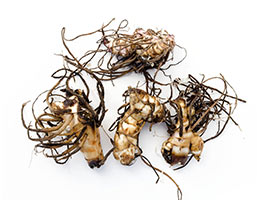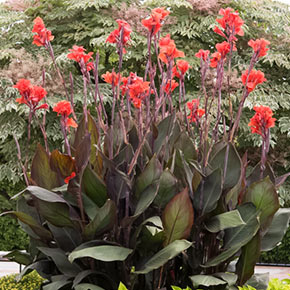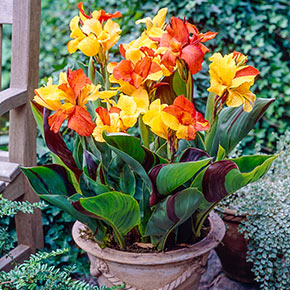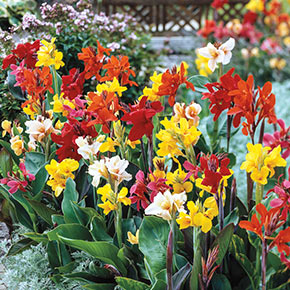-
Spring Planting
Order now for best selections.
-
Fall Planting
Available for preorder for fall 2025 delivery.
-
Bulk Flower Bulbs
Big savings on bulk orders!
- New
-
Gardening Resources
Flower Bulbs & Perennials at Wholesale Prices

How to Grow Cannas
| Botanical Name | Canna |
| Plant Type | Rhizome |
| Sun Exposure | Full sun |
| Soil Type | Well-drained, loamy, sandy or clay soils |
| Soil pH | Slightly acidic to neutral |
| Bloom Time | Midsummer to first frost |
| Flower Color | Orange, yellow, red, pink, white |
| Hardiness Zones | 3-10 (lift in fall in zones 3-7) |
| Special Features | Container friendly. Available in giant and dwarf sizes. |
With cannas, you can enjoy a taste of the tropics without ever leaving home. Gardeners have long loved these tropical-looking flowers for their huge, colorful, paddle-shaped leaves and showy flowers. Available in giant sizes that reach 6 ft. or taller or dwarf sizes that are easy to tuck into containers, sun-loving cannas can be grown without a lot of fuss. When you grow cannas in your garden or on your sunny patio or deck, you can feel like you're on a topical vacation.
Growing these showy flowers is easier than you may think. Just follow this guide on selecting the right cannas, planting and caring for them. Once gardeners start growing cannas and discover how easy it is, they find more ways to incorporate them into their gardens, landscapes and sunny patio settings.

How to Plant Cannas Bulbs
When planting cannas, the soil temperature should be at least 60 degrees F. Because cannas like fertile soil rich in organic matter, mix compost into the soil before planting. This also helps improve drainage. If planting cannas in containers, then use a quality potting mix. Cannas benefit from an all-natural, slow-release fertilizer, such Van Bourgondien 100% Natural Bulb Food.
How Deep to Plant Cannas
Place the rhizome horizontally, eyes up, in the soil about 1-3" deep. Cover lightly with soil and water.
How Far Apart to Space Cannas
If planting in the garden, space the canna bulbs about 15-24" apart. The spacing is often closer when planting in a container.
When Do You Plant Cannas Bulbs?
Tender perennials, cannas are planted in the garden in late spring to early summer, after the danger of frost has passed. To get a jumpstart on tropical blooms and foliage, many Northern gardeners will start canna rhizomes indoors about four weeks before transplanting them to the garden. Because the selection is often best in late winter to early spring, order your canna bulbs then.
Where to Plant Cannas
Cannas are sun lovers and grow best in areas that receive six or more hours of direct sunlight daily. They can grow in well-drained sandy, loamy or clay soil that is slightly acidic to neutral. While they prefer moist soil, they don't like to sit in water. Because of their large leaf size, avoid planting cannas in areas exposed to high winds.
While canna rhizomes can be grown in zones 3-10, they cannot handle overwintering in the ground in zones 3-6. In some areas of zone 7, they can overwinter in the ground. To find out your grow zone, use our zone finder tool.
How to Grow Cannas
Canna rhizomes usually sprout 1-3 weeks after planting. Once they sprout, make sure they receive 1" of rainfall or the equivalent amount of water weekly. During the hot days of summer, water more often. The soil should be kept moist, not soggy. A thin layer of mulch helps retain moisture and suppress weeds.
Creating a tropical look with cannas is fairly easy as long as you remember a few things:How to Grow Cannas from Seed
Because cannas are difficult to grow from seed and often have a low germination rate, most gardeners plant rhizomes. If growing cannas from seed, soak them in lukewarm water for about 24 hours before planting. Canna seeds usually germinate in 7-14 days.
Harvesting Cannas
When cannas bloom, you can cut the flowers for showy, cut-floral displays. Deadheading the spent flowers encourages more blooms and makes for a tidier appearance in the garden.
Do You Need to Dig up Cannas?
If you live in zones 8-10, canna rhizomes can overwinter in the ground. In zones 3-6, cannas can either be grown as annuals, or the rhizomes can be dug up and brought indoors. In zone 7, cannas may survive overwinter in the ground, depending on your location.
When Do You Need to Dig up Cannas?
In zone 3-7, cut the stems and leaves after the first fall frost. Dig up the canna bulbs before the first freeze.
How Do You Need to Dig up Cannas?
When digging up cannas, shake the soil from the rhizomes and allow them to dry for a few days. Store them between layers of newspaper or in peat moss in a cool, dry place such as an unheated basement. The rhizomes can be planted in the garden the following spring. In zones 8-10, canna bulbs can be divided in the winter every 3-4 years.
Cannas Pests & Diseases
If cannas are planted in poorly drained, wet soils, the rhizomes may rot. If the canna plants are overcrowded, they are more susceptible to diseases such as canna rust or bacterial leaf spot. Slugs and snails may also chew on the foliage. Inspect your canna plants frequently for other pests such as Japanese beetles, caterpillars and spider mites. Viruses that may affect cannas include the bean yellow mosaic virus and tomato spotted wilt virus.
Canna FAQs
Do Cannas Come Back Every Year?
Cannas are tender perennials that come back year after year in zones 8-10. In cooler zones, canna rhizomes must be dug up in the fall, stored indoors over winter and replanted in the spring.Where do Cannas Grow Best?
Cannas grow best in full sun and in well-drained, moist soil, rich in organic matter.Do Cannas Need Full Sun?
Cannas grow best in six or more hours of direct sunlight daily.What Time of Year do You Plant Canna Bulbs?
Canna rhizomes are planted in late spring to early summer, after the last frost in your area.Types of Cannas
Cannas are available in various sizes and flower colors. Here are a few popular types of cannas. Giant Cannas: Growing 36-72" tall, and sometimes taller, Giant Cannas are often seen covering large areas in parks and other public settings. These impressive, sun-loving plants are available in a wide selection of flower and foliage colors and are ideal for back borders and large patio pots.
Giant Cannas: Growing 36-72" tall, and sometimes taller, Giant Cannas are often seen covering large areas in parks and other public settings. These impressive, sun-loving plants are available in a wide selection of flower and foliage colors and are ideal for back borders and large patio pots.-
 Dwarf Cannas: Shorter than their giant cousins, Dwarf Cannas grow 24-36" tall, are available in an array of flower and foliage colors and are perfect for sunny perennial borders and patio containers. They're also a showy addition to mixed container plantings.
Dwarf Cannas: Shorter than their giant cousins, Dwarf Cannas grow 24-36" tall, are available in an array of flower and foliage colors and are perfect for sunny perennial borders and patio containers. They're also a showy addition to mixed container plantings. -
 Mixed Cannas: Mixed cannas offer an economical and fun way to try different canna varieties. Available in dwarf and giant sizes, these random mixes offer different flower and foliage colors.
Mixed Cannas: Mixed cannas offer an economical and fun way to try different canna varieties. Available in dwarf and giant sizes, these random mixes offer different flower and foliage colors.
| Shop All Flower Bulbs | |
| See More Tips |
Have another question? Return to the Customer Service Help page or send an e-mail directly to Customer Service
Copyright © 2025 Gardens Alive!, Inc. d/b/a Dutchbulbs.com. All Rights Reserved. Dutchbulbs.com trademarks are registered trademarks of Gardens Alive!, Inc.
This site is protected by reCAPTCHA and Google Privacy Policy and Terms apply.
This site is protected by reCAPTCHA and Google Privacy Policy and Terms apply.

Item added to cart





